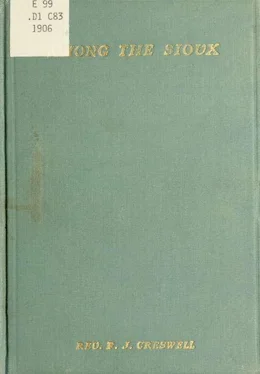Creswell, J.) - Among the Sioux - a story of the Twin Cities and the two Dakotas
Здесь есть возможность читать онлайн «Creswell, J.) - Among the Sioux - a story of the Twin Cities and the two Dakotas» весь текст электронной книги совершенно бесплатно (целиком полную версию без сокращений). В некоторых случаях можно слушать аудио, скачать через торрент в формате fb2 и присутствует краткое содержание. Жанр: Старинная литература, на английском языке. Описание произведения, (предисловие) а так же отзывы посетителей доступны на портале библиотеки ЛибКат.
- Название:Among the Sioux : a story of the Twin Cities and the two Dakotas
- Автор:
- Жанр:
- Год:неизвестен
- ISBN:нет данных
- Рейтинг книги:5 / 5. Голосов: 1
-
Избранное:Добавить в избранное
- Отзывы:
-
Ваша оценка:
- 100
- 1
- 2
- 3
- 4
- 5
Among the Sioux : a story of the Twin Cities and the two Dakotas: краткое содержание, описание и аннотация
Предлагаем к чтению аннотацию, описание, краткое содержание или предисловие (зависит от того, что написал сам автор книги «Among the Sioux : a story of the Twin Cities and the two Dakotas»). Если вы не нашли необходимую информацию о книге — напишите в комментариях, мы постараемся отыскать её.
Among the Sioux : a story of the Twin Cities and the two Dakotas — читать онлайн бесплатно полную книгу (весь текст) целиком
Ниже представлен текст книги, разбитый по страницам. Система сохранения места последней прочитанной страницы, позволяет с удобством читать онлайн бесплатно книгу «Among the Sioux : a story of the Twin Cities and the two Dakotas», без необходимости каждый раз заново искать на чём Вы остановились. Поставьте закладку, и сможете в любой момент перейти на страницу, на которой закончили чтение.
Интервал:
Закладка:
II—HER WORK AMONG THE DAKOTAS.
This covers one-third of a century. The missionary spirit was a part of her life,—born with her,—a heritage of several generations. The blood of the Newtons flowed in her veins. When she arrived in Minnesota, she went to work without delay and with great energy and with untiring industry greatly -beyond her strength. She was very familiar with the Bible. She taught hundreds of Indians, perhaps fully one thousand, to read the Word of God, and the greater part of them tc write a legible letter. She visited all
the sick within her reach, and devoted much of her time to instructing the Dakota women in domestic duties. She conducted prayer meetings and conversed with them in reference to the salvation of their souls. Many of them, saved by the Holy Spirit's benediction upon her self-denying efforts, are now shining like bright gems in her crown of glory on high.
Lac-qui-Parle,—the Lake-that-speaks,—^two hundred miles west of St. Paul, was her first missionary home. There she gathered the young Indians together and taught them as opportunity offered. The instruction of the youth—especially the children, of whom she was ever a devoted lover, was her great delight.
It was more than a year before any mail reached her at this remote outpost. She was absent in the Indian village when she heard of the arrival of her first mail. She. in her eagerness to hear from her friends in Ohio, ran like a young woman to her brother's house. She found the mail in the stove-oven. The carrier had brought it through the ice, and it had to be thawed out. That mail contained more than fifty letters for Iitr and the postage on them was over five dollars In 1846, she removed with her brother to Kaposia, Little Crow's village (now South St. Paul), and in 1852 to Yellow Medicine, thirty-two miles south of Lac-qui-Parle. The privations of the missionaries were very great. White bread was more of a luxury to them then, than rich cake ordinarily is now. Their houses and furnishings were of the rudest kind. Their environments were all of a savage character.
y6 AMONG THE SIOUX.
Their trials were many and sore, extreme scarcity of food in mid-winter, savage threats and bitter in-snks. Thev were ''in journeying-s often, in perils of waters, of robbers, by the heathen and in the wilderness." All this she endured contentedly for Christ's sake and the souls of the poor ignorant savages around for the evangelization and salvation of the degraded Dakotas,—lost in sin.
She possessed great tact and was absolutely fearless. In 1857. during the Inkpadoota trouble, the father of a young Indian, who had been wounded by the soldiers of Sherman's battery, came with his gun to the mission house to kill her brother. Aunt Jane met him with a plate of food for himself and an ofifer to send some nice dishes to the wounded young man. This vv^as effectual. The savage was tamed. He ate the food and afterwards came with his son to give them thanks. Scarcely was the prison-camp, with nearly four hundred Dakota prisoners, three-fourths of them condemned to be hanged, established at Mankato, ^/hen Aunt Jane and her brother came to distribute paper and pencils and some books among them.
When their lives were imix^rilled, by their savage pursuers, during the terrible massacre^ Aunt Jane calmly said; "Well if they kill me, my home is in Heaven." The churches were scattered, the work apparently destroyed, but nothing could discourage Aunt Jane. She had, in the midst of this great tragedy, the satisfactory knowledge that all the Christian Sioux had continued at the risk of their own lives, steadfast in their lovaltv, and had been instrumental in
SOWING AND REAPING. -jj
saving the lives of many whites. They had, also, influenced for g-ood many of their own race.
TIT—TTiE CrX)SING YEARS OF HER LIFE.
After that terrible massacre the way never opened for her to resume her residence among the Dakotas; but she was given health and strength for nineteen years more toil for the Master and her beloved Indians. Her home was with her brother, Dr. Williamson, near St. Peter, until his death in 1879, and she remained, in his old home several years after his death. During this period, slie accomplished much for the education of the Indians around her and she kept up an extensive and helpful correspondence with native Christian workers. All the time she kept up the work of self-sacrifice for the good of others. In 1881 she met a poor Indian woman, su fife ring extremely from intense cold. She slipped ofif her own warm skirt and gave it to the woman. The result was a severe illness, which caused her partial paralysis and total blindness from which she never recovered. In 1888 she handed the writer a $5 gold coin for the work among the ireedmen with this remark: '* First the f reedman ; then the Indian." Out of a narrow income she constantly gave generously to the 'boards of the church and to the poor around her. She spent most of her patrimony in giving and lending to needy ones.
The closing years of her life were spent with her nephew the great Indian missionary the Rev. John P. Williamson D.D. at Greenwood, South Dakota. There at noon of March 24, 1895, the light of eternity dawn-
; 8 AMONG THE SIOUX.
ed upon her and she entered into that sabbattic rest, which remains for the people of God. Such is the stors' of Aunt Jane, modest and unassuming—a real heroine,, who travelled sixteen hundred miles all the way on horseback and spent several months that she might rescue two poor colored persons whom she had never seen or even known.
Without husband or children, alone in the world, she did not repine, but made herself useful, wherever she was, in teaching secular learning and religiou.s truth, and in ministering to the sick and afflicted, the down-trodden and oppressed. She never sought to d^-any wonderful things,—but whatever her ^hand found to do, she did it with her might and with an eye to the honor and glory of God. Hers was a very long and most complete Christian life. Should it ever be forgotten? Certainly not. while our Christian religion endures.
"Blessed are the dead which die in the Lord from henceforth; yea, saith the Spirit, that they may rest from their labors and their works do follow them."
—Rev. 14: 13.
ARTEMAS, THE WARRIOR PREACHER
He was one of the fiercest of the Sioux warriors. He fought the Ojibways in his youth; danced the scalp-dance on the present site of MinneapoHs, and waged war against the whites in '62. He was converted at Mankato, Minnesota, in the prison-pen, and for thirty-two years, he was pastor of the Pilgrim Congregational church at Santee, Nebraska.
Artemas Ehnamane was born in 1825, at Red Wing, Minnesota, by the mountain that stands sentinel at the head of Lake Pepin. ''Walking Along" is the English translation of his jaw-breaking surname. As a lad, he played on the banks of the mighty Mississippi. As a youth, he hunted the red deer in the lovely glades of Minnesota and Wisconsin. He soon grew tall and strong and became a famous hunter. The war-path, also, opened to him in the pursuit of his hereditary foes, the Chippewas. He danced the scalp-dance on the present site of Minneapolis, when it was only a wind-swept prairie.
While in his youth, his tribe ceded their ancestral lands along the Mississippi and removed to the Sioux Reservation on the Minnesota River. But not for long, for the terrible outbreak of 1862, scattered everything and landed all the leading men of that tribe in prison. Artemas was one of them. He was convicted, condemned to death, and pardoned by Abraham Lincoln. While in the prison-pen at Mankato,
Su AMONG THE SIOUX.
he came into a new life ''that thinketh no evil of his neighbor." The words of the faithful missionaries, Pond and Williamson and Riggs, sank deep into his heart. His whole nature underwent a change. Arte-mas once explained his conversion thus:
Читать дальшеИнтервал:
Закладка:
Похожие книги на «Among the Sioux : a story of the Twin Cities and the two Dakotas»
Представляем Вашему вниманию похожие книги на «Among the Sioux : a story of the Twin Cities and the two Dakotas» списком для выбора. Мы отобрали схожую по названию и смыслу литературу в надежде предоставить читателям больше вариантов отыскать новые, интересные, ещё непрочитанные произведения.
Обсуждение, отзывы о книге «Among the Sioux : a story of the Twin Cities and the two Dakotas» и просто собственные мнения читателей. Оставьте ваши комментарии, напишите, что Вы думаете о произведении, его смысле или главных героях. Укажите что конкретно понравилось, а что нет, и почему Вы так считаете.












